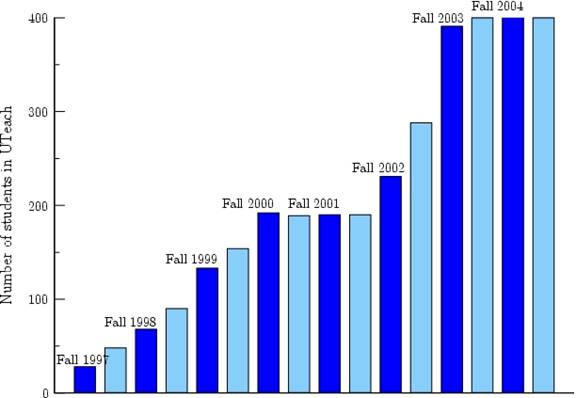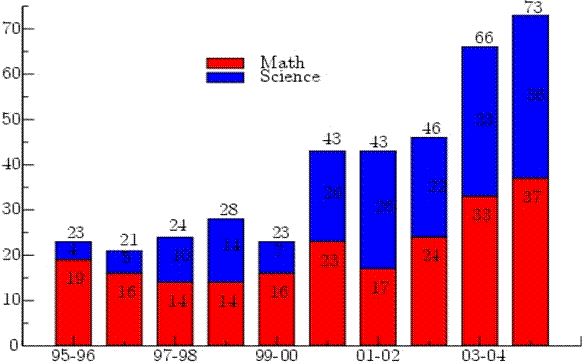Forum on Education of The American Physical Society
Fall 2005 Newsletter
|
UTeach Michael Marder History UTeach, at the University of Texas at Austin, has become one of the largest and most successful programs preparing secondary science and mathematics teachers at a research university in the US. It came in part from the long delayed action of a law that had almost been forgotten by the time it had an effect. The law was Texas Senate Bill 994 of 1987. Arguing that "greater numbers of bright students should be encouraged to enter the teaching profession" the law required that "undergraduate requirements for professional teacher education not extend beyond the quantitative equivalent of a typical minor." Secondary teachers were required to major in their discipline. Secondary education majors were abolished. Education coursework was capped at 18 hours. Responsibility for preparing teachers had been removed from education faculty, but without clearly being turned over to anyone else. The number of students obtaining secondary certification began to drop, particularly in the sciences. In 1997-1998, only 10 science majors obtained secondary certification in science at UT Austin, down from around 20 per year a decade before. Over 30 states now have such laws, and given today's insistence on basing educational decisions upon research, it would be interesting to see what their effect has been. In 1997, the Dean of the College of Natural Sciences at UT Austin, Mary Ann Rankin, began searching for an alternative to outreach in the hopes of improving public school science and mathematics education. The greatest impact, she reasoned, would come not from after-school activities or summer camps, but by helping some of the College's best students to embark on careers as teachers. With encouragement and seed funding from Jeff Kodosky, physicist and co-founder of National Instruments, she convened a group of four award-winning secondary teachers, who spent the summer preparing a report on how they thought secondary teachers should ideally be prepared. One of these Master Teachers, former Texas Teacher of the Year Mary Long, took a permanent position with the college, and a first group 28 students enrolled in the fall of 1997. I joined the effort in the spring of 1998, rather unsure how all the courses needed to certify these students could be created or what they would be, but hopeful that since a measure of responsibility for teacher preparation had in principle been turned over to the college of science some solution should be possible. Apart from a tenured position in the physics department, and a high level of enthusiasm for the task at hand, my qualifications to lead a large new effort in teacher preparation were not obvious. The Program The development of UTeach involved many choices. It is hard to check the necessity and effectiveness of the primary components of UTeach in a systematic way, because we are reluctant to remove one by one the very elements that have made UTeach successful. Nonetheless, here are a few of what we believe to be the most important elements of our program: Master Teachers The instructional staff for UTeach within the College of Natural Sciences largely consists of former secondary teachers, employed full time to teach courses, organize field experiences for the future teachers including student teaching, and assist with many facets of education and outreach. We now employ seven. Field Experience UTeach begins with two one-hour courses that get students out into public schools as quickly as possible to begin teaching carefully supervised lessons. Field experience continues throughout the program and is woven into most of the courses. The logic behind early field experience is that prospective teachers should find out as soon as possible whether they actually enjoy teaching children, and should make a graceful exit if they do not. Typically around 60% of those who begin the first one-hour courses continue on to the 3-hours courses. Collaboration UTeach involved from the start a very close collaboration with the College of Education. Jere Confrey, a Professor of Mathematics Education, was a co-founder of the program and greatly influenced all the UTeach courses. Three three-hour courses at the heart of UTeach have been developed and taught by the College of Education faculty. These courses are specific to the challenges of teaching secondary mathematics and science, and have little overlap with courses taught to elementary teachers. Traditional classes such as Observation, Educational Psychology, and Science Methods were eliminated in favor of a course sequence that focuses on how students learn, how teachers and students interact in classrooms, and how projects can be used to develop units of instruction. UTeach is administered by a joint committee from Education and Natural Sciences, and has co-directors in Education and Natural Sciences. Degree Plans We insist that all degree plans within UTeach be possible to finish within four years, and therefore UTeach poses no financial burden for a student who was going to obtain a degree anyway. Some UTeach students graduate under regular degree plans, adding teaching courses as a concentration. In addition we have worked out with every department in the College a Teaching Option that shaves off a small number of upper-division classes to make room for teaching coursework. Student Support We work aggressively to support students within UTeach. We reimburse them for the cost of the two introductory one-hour courses. All students are eligible to take internships, which are paid jobs with educational nonprofit organizations that range from opportunities to tutor children to preparation of educational software. We constantly search for scholarship support, and are able to give almost every student thousands of dollars to support their education. We have an excellent advising staff, and all instructors try to get to know the students, and to make UTeach a supportive community. Funding Rather than relying upon a succession of grants, the bulk of UTeach funding comes from permanent funds of the College of Natural Sciences. The Master Teachers, advisers, and additional support staff essentially constitute a new department, one that is devoted to preparing teachers. We have also raised a substantial endowment that enables us to support students, and to pay stipends to hundreds of teachers in the local school district who host our students and observe them during the field experiences. Recruitment We send letters about UTeach to all students entering the College of Natural Sciences as freshmen or as transfers. We mention UTeach during all College orientation sessions. We mail a letter to all continuing students once a year, and make public announcements about scholarship opportunities or other notable events so that the university community remains aware of our existence. Other Elements All UTeach students prepare a portfolio that documents their progress toward teaching proficiency. We have a required course on the history and philosophy of science and mathematics, a required course on performing scientific research, and a course on reading strategies. Students learn early on to prepare 5-E lesson plans1, and employ this format through much of the program. We find that prospective teachers tend to want a carefully structured education, so we have developed many rubrics, including one for the process of scientific inquiry.
Figure 1: Growth of UTeach from 1997 to the present. Outcomes UTeach has grown to over 400 students, as shown in Figure 1. The number of graduates is shown in Figure 2 on the following page. Almost half the students are math majors, with the majority of science students majoring in biology. The number of UTeach physics majors is around 10, with 2-3 students obtaining physics certification per year. Sadly, this is a substantial percentage of the state total. The students overall are strong, with SAT scores and grade point averages a bit above the college as a whole. In addition to typical undergraduates, we also welcome applicants with college degrees who wish to obtain teaching certification. Our earliest graduates have been out now for four and five years, and over 75% of them are still teaching. We try to remain in touch with them and provide services ranging from extra support during the first critical years to a new Master's degree program. Several other universities have already implemented programs that are loosely or closely based upon UTeach. The largest initiative to be influenced heavily by UTeach is the Science and Mathematics initiative in California2. UTeach required effort and planning to create, but its ingredients are not unique to Texas. Each UTeach graduate has a much more profound impact on public school students than the university could obtain in any other way. The frightening gap in mathematical and scientific competence between students in the US and other countries will not easily close, but we believe that helping strong students become great teachers is the best way to make progress.
References 1) http://www.bscs.org/page.asp?pageid=0|31|95|96&id=0|bscs_5es 2) http://www.universityofcalifornia.edu/academics/1000teachers/ Michael Marder is Professor of Physics and Co-Director of UTeach at The University of Texas at Austin. More information about UTeach is available at http://uteach.utexas.edu |

